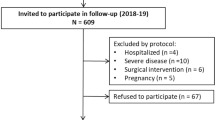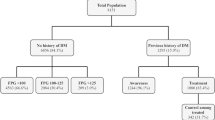Abstract
Diabetes is a major health problem around the world. The risk of diabetes is increasing worldwide, and its misdiagnosis may have significant public health implications. This study aimed to determine the prevalence of diabetes and its risk factors among the middle-aged population in Shahroud, north of Iran. In the present study, the plasma glucose levels in 5190 subjects aged 40–64 years, participating in the first phase of the Shahroud Eye Cohort Study in 2009, were measured. Non-fasting glucose level greater than or equal to 200 mg/dl and/or the use of blood glucose-lowering drugs were considered as criteria for the diagnosis of diabetes. To determine the risk factors associated with diabetes, simple and multivariate logistic regressions were used. The prevalence of diabetes in men, women, and the total population were 10.4, 13.6, and 12.3 %, respectively. The mean blood glucose levels in men and women were 116.7 and 117.3 mg/dl, respectively. Age (odds ratio (OR) = 1.04), hypertension (OR = 2.5), being overweight (OR = 1.5), and obesity (OR = 1.5) were positively associated with diabetes. In addition, having an insurance (OR = 0.48) and male gender (OR = 0.81) was associated with a reduced risk of diabetes. Based on the results of the present study, the prevalence of diabetes in the studied population is high, and according to the epidemiological transition of diseases, a high percentage of the Iranian population are at risk for cardiovascular diseases. Considering the risk factors identified in the present study, developing effective interventions is essential.
Similar content being viewed by others
References
International Diabetes Federation. IDF diabetes atlas. 6th ed. Brussels: International Diabetes Federation; 2013.
Wild S, Roglic G, Green A, Sicree R, King H. Global prevalence of diabetes: estimates for the year 2000 and projections for 2030. Diabetes Care. 2004;27:1047–53.
Zimmet P, Alberti KGMM, Shaw J. Global and societal implications of the diabetes epidemic. Nature. 2001;414:782–7.
Chen L, Magliano DJ, Zimmet PZ. The worldwide epidemiology of type 2 diabetes mellitus—present and future perspectives. Nat Rev Endocrinol. 2012;8:228–36.
Whiting DR, Guariguata L, Weil C, Shaw J. IDF diabetes atlas: global estimates of the prevalence of diabetes for 2011 and 2030. Diabetes Res Clin Pract. 2011;94:311–21.
Boyko EJ, Jacobson IG, Smith B, Ryan MAK, Hooper TI, Amoroso PJ, et al. Risk of diabetes in U.S. military service members in relation to combat deployment and mental health. Diabetes Care. 2010;33:1771–7.
Esteghamati A, Khalilzadeh O, Anvari M, Meysamie A, Abbasi M, Forouzanfar M, et al. The economic costs of diabetes: a population-based study in Tehran. Iran Diabetol. 2009;52:1520–7.
Barcelo A, Aedo C, Rajpathak S, Robles S. The cost of diabetes in Latin America and the Caribbean. Bull World Health Organ. 2003;81:19–27.
Franse LV, Di Bari M, Shorr RI, Resnick HE, van Eijk JT, Bauer DC, et al. Type 2 diabetes in older well-functioning people: who is undiagnosed? Data from the health, aging, and body composition study. Diabetes Care. 2001;24:2065–70.
Global health risks. Mortality and burden of disease attributable to selected major risks. Geneva: World Health Organization; 2009.
Mathers CD, Loncar D. Projections of global mortality and burden of disease from 2002 to 2030. PLoS Med. 2006;3:e442.
Alwan A. Global status report on noncommunicable diseases 2010. Geneva: World Health Organization; 2011.
Malekzadeh R. Global Burden of Disease Study 2010: a real advance in global descriptive epidemiology: prospective for developing countries. Arch Iran Med. 2014;17:302–3.
Naghavi M, Shahraz S, Sepanlou SG, Dicker D, Naghavi P, Pourmalek F, et al. Health transition in Iran toward chronic diseases based on results of Global Burden of Disease 2010. Arch Iran Med. 2014;17:321–35.
Forouzanfar MH, Sepanlou SG, Shahraz S, Dicker D, Naghavi P, Pourmalek F, et al. Evaluating causes of death and morbidity in Iran, global burden of diseases, injuries, and risk factors study 2010. Arch Iran Med. 2014;17:304–20.
Bozorgmanesh M, Hadaegh F, Sheikholeslami F, Azizi F. Cardiovascular risk and all-cause mortality attributable to diabetes: Tehran lipid and glucose study. J Endocrinol Invest. 2012;35:14–20.
Bozorgmanesh M, Hadaegh F, Sheikholeslami F, Ghanbarian A, Azizi F. Shadow of diabetes over cardiovascular disease: comparative quantification of population-attributable all-cause and cardiovascular mortality. Cardiovasc Diabetol. 2012;11:69.
Jarrett RJ. Epidemiology and public health aspects of non-insulin-dependent diabetes mellitus. Epidemiol Rev. 1989;11:151–71.
Esteghamati A, Etemad K, Koohpayehzadeh J, Abbasi M, Meysamie A, Noshad S, et al. Trends in the prevalence of diabetes and impaired fasting glucose in association with obesity in Iran: 2005–2011. Diabetes Res Clin Pract. 2014;103:319–27.
Esteghamati A, Gouya MM, Abbasi M, Delavari A, Alikhani S, Alaedini F, et al. Prevalence of diabetes and impaired fasting glucose in the adult population of Iran: national survey of risk factors for non-communicable diseases of Iran. Diabetes Care. 2008;31:96–8.
Esteghamati A, Meysamie A, Khalilzadeh O, Rashidi A, Haghazali M, Asgari F, et al. Third national surveillance of risk factors of non-communicable diseases (SuRFNCD-2007) in Iran: methods and results on prevalence of diabetes, hypertension, obesity, central obesity, and dyslipidemia. BMC Public Health. 2009;9:167.
Fotouhi A, Hashemi H, Shariati M, Emamian MH, Yazdani K, Jafarzadehpur E, et al. Cohort profile: Shahroud eye cohort study. Int J Epidemiol. 2013;42:1300–8.
American Diabetes Association. Standards of medical care in diabetes—2013. Diabetes Care. 2013;36:S11–66.
Mahan LK, Escott-Stump S, Raymond JL. Krause’s food, nutrition and diet therapy. 13th ed. Philadelphia: WB Saunders; 2012.
Eskandarian R, Rashidiypour A, Raheb G, Malek M. Epidemiology of diabetes and impaired fasting glucose in adults in the province. Iran J Diabet Lipid. 2009;8:375–82.
Lee CM, Huxley RR, Lam TH, Martiniuk AL, Ueshema H, Pan WH, et al. Prevalence of diabetes mellitus and population attributable fractions for coronary heart disease and stroke mortality in the WHO South-East Asia and Western Pacific regions. Asia Pac J Clin Nutr. 2007;16:187–92.
Forouhi NG, Merrick D, Goyder E, Ferguson BA, Abbas J, Lachowycz K, et al. Diabetes prevalence in England, 2001—estimates from an epidemiological model. Diabet Med. 2006;23:189–97.
Rathmann W, Scheidt-Nave C, Roden M, Herder C. Type 2 diabetes: prevalence and relevance of genetic and acquired factors for its prediction. Deutsches Arzteblatt Int. 2013;110:331–7.
Coppell KJ, Mann JI, Williams SM, Jo E, Drury PL, Miller JC, et al. Prevalence of diagnosed and undiagnosed diabetes and prediabetes in New Zealand: findings from the 2008/09 adult nutrition survey. N Z Med J. 2013;126:23–42.
Cowie CC, Rust KF, Byrd-Holt DD, Eberhardt MS, Flegal KM, Engelgau MM, et al. Prevalence of diabetes and impaired fasting glucose in adults in the U.S. population: national health and nutrition examination survey 1999–2002. Diabetes Care. 2006;29:1263–8.
Hammami S, Mehri S, Hajem S, Koubaa N, Souid H, Hammami M. Prevalence of diabetes mellitus among non institutionalized elderly in Monastir City. BMC Endocr Disord. 2012;12:15.
Al Ali R, Mzayek F, Rastam S, Fouad FM, O'Flaherty M, Capewell S, et al. Forecasting future prevalence of type 2 diabetes mellitus in Syria. BMC Public Health. 2013;13:507.
Albache N, Al Ali R, Rastam S, Fouad FM, Mzayek F, Maziak W. Epidemiology of type 2 diabetes mellitus in Aleppo. Syria J Diabet. 2010;2:85–91.
Danaei G, Finucane MM, Lu Y, Singh GM, Cowan MJ, Paciorek CJ, et al. National, regional, and global trends in fasting plasma glucose and diabetes prevalence since 1980: systematic analysis of health examination surveys and epidemiological studies with 370 country-years and 2·7 million participants. Lancet. 2011;378:31–40.
Azimi-Nezhad M, Ghayour-Mobarhan M, Parizadeh MR, Safarian M, Esmaeili H, Parizadeh SM, et al. Prevalence of type 2 diabetes mellitus in Iran and its relationship with gender, urbanisation, education, marital status and occupation. Singapore Med J. 2008;49:571–6.
Maier W, Holle R, Hunger M, Peters A, Meisinger C, Greiser KH, et al. The impact of regional deprivation and individual socio-economic status on the prevalence of type 2 diabetes in Germany. A pooled analysis of five population-based studies. Diabet Med. 2013;30:e78–86.
Onat A, Hergenç G, Uyarel H, Can G, Ozhan H. Prevalence, incidence, predictors and outcome of type 2 diabetes in Turkey. Anatolian J Cardiol. 2006;6:314–21.
Shrestha UK, Singh DL, Bhattarai MD. The prevalence of hypertension and diabetes defined by fasting and 2-h plasma glucose criteria in urban Nepal. Diabet Med. 2006;23:1130–5.
Acknowledgments
This project was supported by the Noor Ophthalmology Research Center and Shahroud University of Medical Sciences.
Conflict of interest
The authors declare that they have no competing interest.
Author information
Authors and Affiliations
Corresponding author
Rights and permissions
About this article
Cite this article
Ebrahimi, H., Emamian, M.H., Shariati, M. et al. Diabetes mellitus and its risk factors among a middle-aged population of Iran, a population-based study. Int J Diabetes Dev Ctries 36, 189–196 (2016). https://doi.org/10.1007/s13410-015-0397-x
Received:
Accepted:
Published:
Issue Date:
DOI: https://doi.org/10.1007/s13410-015-0397-x




